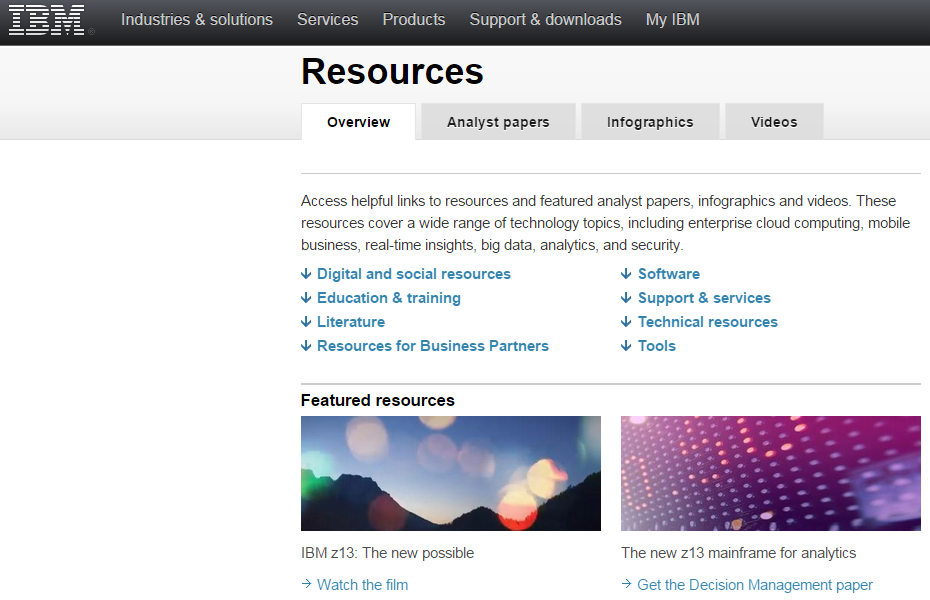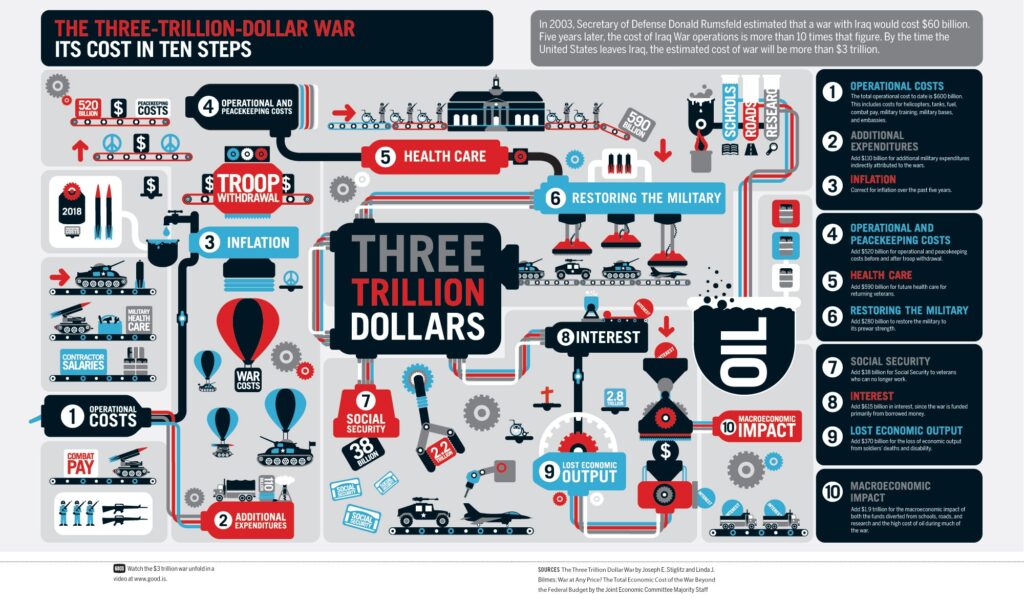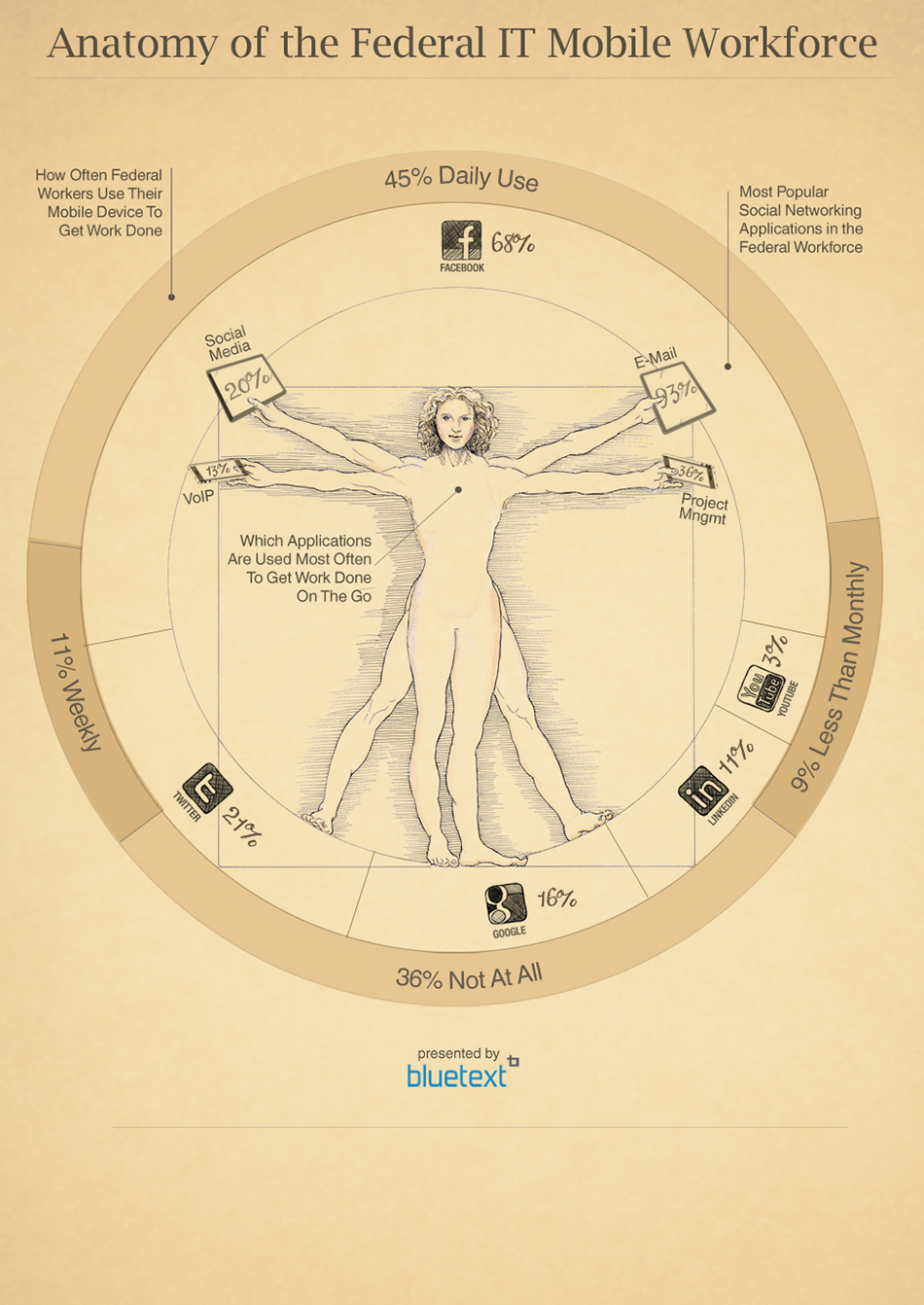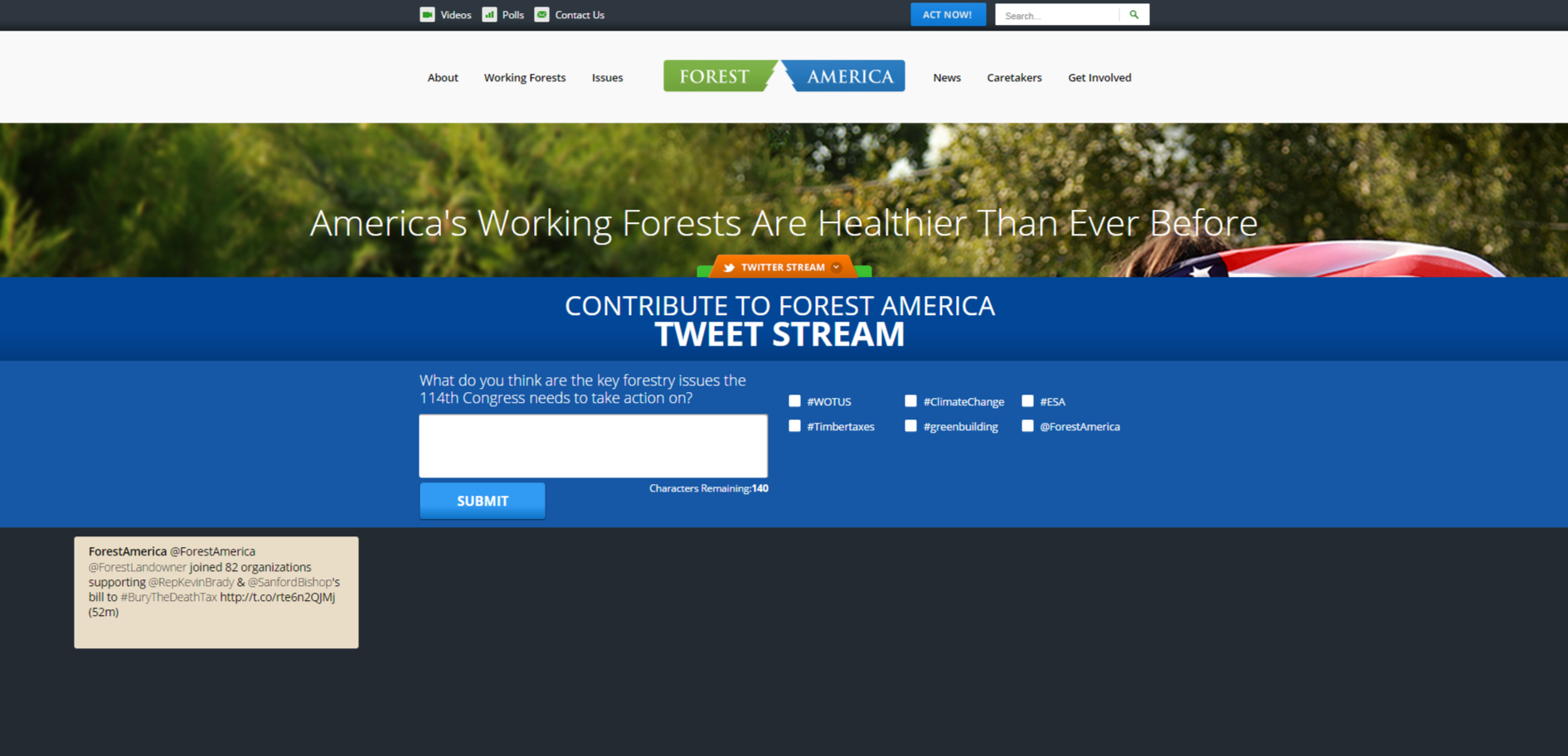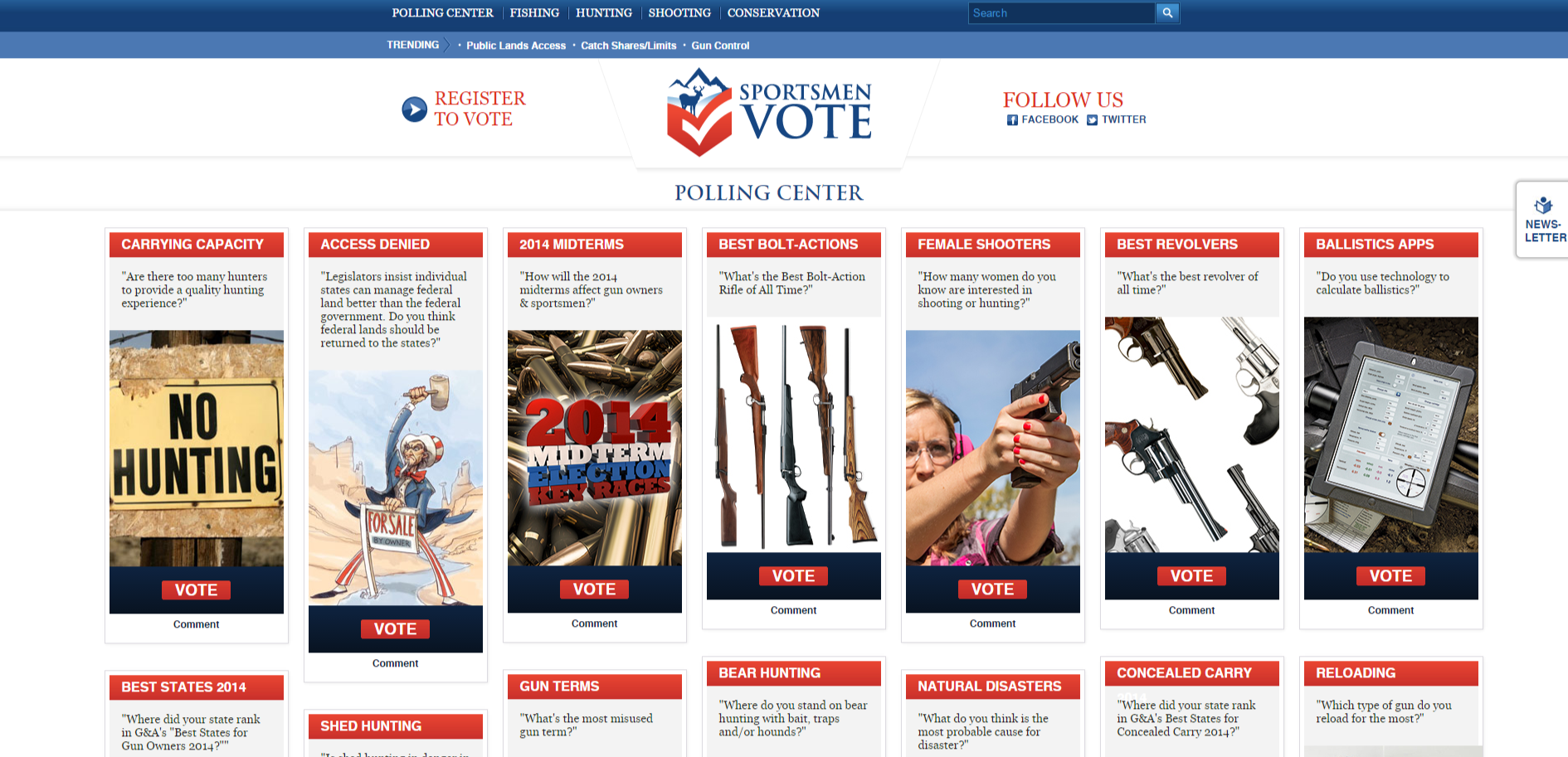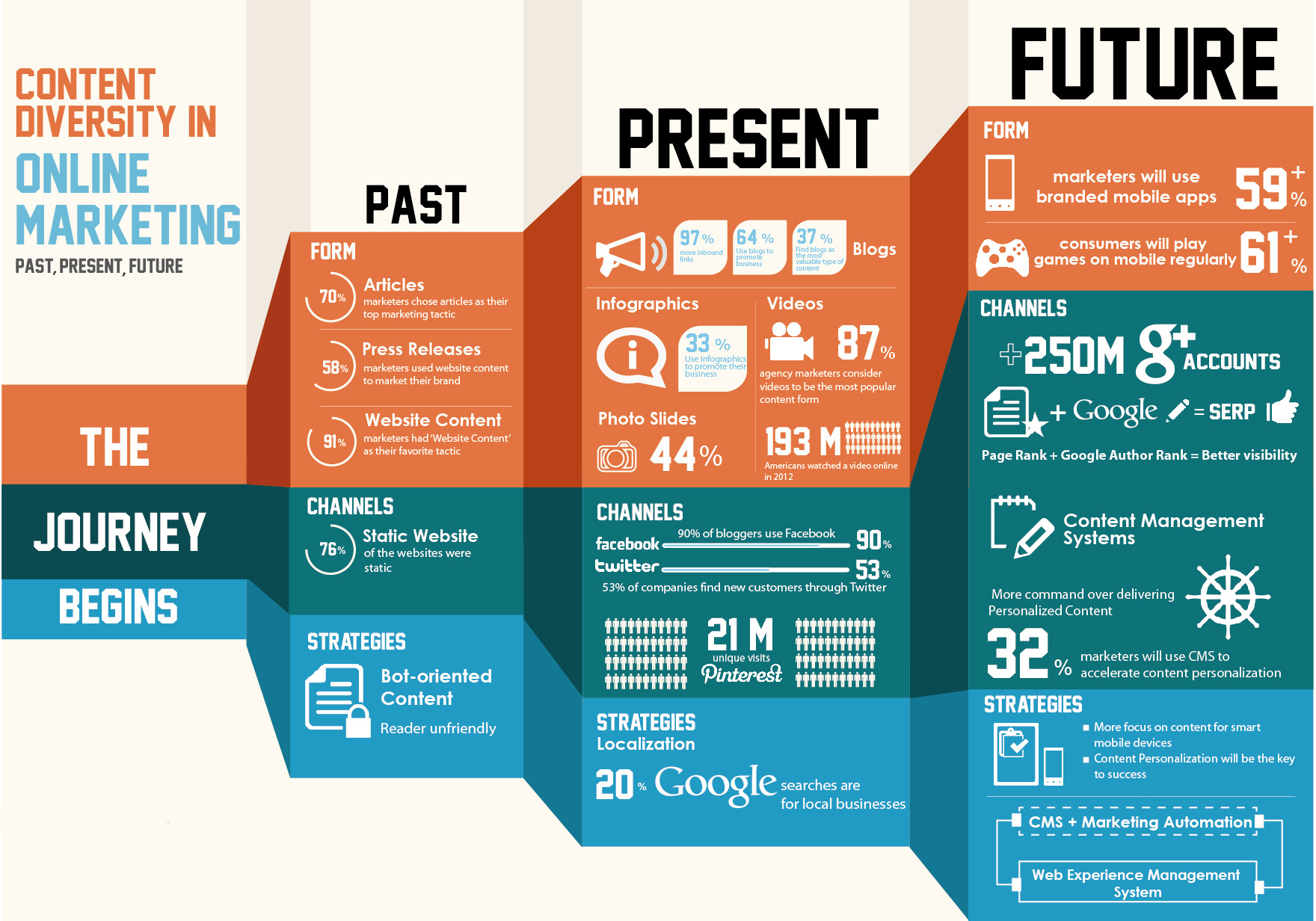Innovation in content marketing is nothing new, but sometimes it takes well-known brands and how they drive their marketing operations to recognize what’s really valuable. We’ve gathered some top content marketing examples and tips from some of the most recognizable global companies. Some aren’t only about innovation, but rather they show companies sticking to what’s most important about that brand. Others are more on the cutting edge. Here are my four top picks:
1) Pick a strategy that is core to your brand. IBM is known for three key assets: Its technical expertise, its role as long-time market leader, and its position as a respected source of IT information. To match its steady flow of content to its brand attributes IBM follows the same path. To uphold its reputation as a technology leader for more than a century, it has to produce authoritative content that underscores its thought leadership. Because the company is a technical powerhouse, it has to ensure that the content is technically authoritative. And because the company is trusted by millions to provide detailed descriptions of challenges and solutions, it has to make sure that its content is at an expert level. While trying to follow in IBM’s footsteps is not an easy task, it provides a strong lesson for how to approach your content. It should be well-written, possess authority, and have an expert voice. That’s what customers want and respond to.
2) Don’t be boring. This might sound obvious, but with many business-to-business or business-to-government solutions, it’s not always easy to sound interesting on technical topics. Resist the temptation to edit out content that might be fun and relevant, and that plays on popular topics or cultural experiences. Take Hootsuite as an example. There’s nothing very sexy about a tool that allows you to manage your social media posts. It’s mostly a dashboard with a number of useful applications tacked on. But Hootsuite rose to immense popularity by playing off a popular theme, the HBO television series “Game of Thrones.” It created a video called “Game of Social Thrones,” using graphics and music similar to the television show to demonstrate its capabilities. Each popular social platform has its own Game of Thrones city, and logos and images are cleverly used throughout. Timing is everything, of course, and the Hootsuite video garnered lots of buzz on YouTube. Hootsuite also makes sure that its content, even when serious, is fun, increasing its popular appeal. So while your brand or product may be technical and specialized, you can still write content with which your audience will identify on a popular level. The lesson: Don’t feel that you need to be serious all of the time. Create some fun, light content now and then.
3) Tell stories. It’s easy to fall back on technical explanations, and these are often important when conveying the value that a product or solution brings to the market. But telling a human interest story that illustrates what that technology brings to customers can be much more penetrating. Few do this better than Microsoft, whose “Stories” blog posts rarely even include the term software. Instead, they tell stories of how Microsoft technology has helped people, and in some cases changed their lives. In one example featuring sportscaster Daniel Jeremiah, the story is one of the human experience, of triumph, challenge and redemption. Daniel explains how as a scout for the Philadelphia Eagles, when he didn’t trust his instincts and the data at his disposal, he lost the opportunity to push for Seattle Seahawks superstar Russell Wilson. It’s a fun,personal and powerful story, and one that demonstrates Microsoft’s leadership not with a hard sell of its products, but with a tale that will stick in your mind.
4) Go visual. Visual images draw attention, tell a story, and help illustrate a brand’s true value. The problem is, many companies, particularly in the technology space, don’t believe they have much they can show using photos or high-impact graphics. I’m going to put forward GoPro as a great example of a company that relies on the visual to tell it brand story. And yes, I recognize that it’s not a fair comparison—a company that sells action-oriented video equipment of course would have great videos to show off its products. But the thing about GoPro is that it almost never actually shows its cameras in its marketing efforts. Instead, GoPro focuses on its users. One of its leading cameras is called the Hero, and its campaign is to turn its customers into heroes. Much of its content is created by passionate users who are, in turn, becoming public heroes. Companies who aren’t in the video business can take a similar approach. Tell the story of your customers and end users using video and other visual assets to make them the heroes—for the challenges they are addressing and the problems they are solving. At the very least, use visual content and images to enhance your text-based content.
Taking an innovative approach to content marketing can pay off in spades for any brand willing to think creatively and act accordingly. But sticking to some basic truths about what customers want and expect will increase your brand footprint and drive market recognition and share.
The lowly infographic, once a novelty but more recently a must-have for markets trying to quickly a complicated message, seems to be in the twilight of its existence. What’s more properly referred to as a data visualization used to command the attention and admiration of marketing professionals everywhere. It wasn’t too long ago that such iconic and influential infographics as Aaron Koblin’s map of aircraft flights in the U.S. was dazzling us and pushing everyone towards this engaging new medium.
It’s easy to see why infographics became the darling of the marketing world. People like to be able to visualize complex issues. Our eyes are more comfortable scanning images than wading through data. And with the explosion of big data, making sense of all for that information through text alone can be difficult. We have worked with dozens of clients on ways to visualize and animate their complex data. The truth about infographics is that they are effective when done well, and will continue to be a valuable asset in the marketing toolkit.
Then why do they seem to be falling out of favor? Indeed, according to Sarah Rapp with the portfolio-sharing site Behance, “Infographic posting generally rose steadily from 2007 to 2012, where it peaked, and has begun to decline since then.”
As Fast Company contributor Mark Wilson wrote in a recent blog post, “A few years ago, the Internet was awash in groundbreaking data visualizations…Today, you’d be lucky to find a cheap knockoff in a world dominated by crappy promotional infographics churned out for viral attention.”
There are a few trends that help explain why infographics may seem like they are losing steam. One of the most obvious is the move to mobile, and as any reader of our recent blog post on the latest Google search algorithm change has learned, websites that aren’t mobile friendly are getting dinged in web searches. The reason is obvious—beautiful and intricate graphics typically do not translate to small-screen devices. If smartphones and tablets make up more than half of today’s web traffic, that’s a massive amount of viewers on which a sprawling data visualization would be lost.
Another is more basic. Many infographics try to pack in so many details and so many data comparisons that they become incomprehensible. Rather than simplifying information, they end up confusing the viewer to the point of their eyes glazing over. Good designs are simple and eye-catching, not complicated and mind-numbing. Here’s an example of data overload:
Finally, as Mark Wilson notes, in many ways infographics have gone mainstream. “Once a playground for independent designers, data visualization has evolved into something more mature, corporate, and honest about its failings,” writes Wilson. “The quirky, experimental infographics that once peppered the Internet may be disappearing. But that’s only because data visualization, as a medium, has finally grown up and gotten a job.”
Bluetext comes at visualization from a different angle. We often work with our clients on what we call “StoryGraphics.” StoryGraphics, as the name suggests, tell a story rather than relying on comparative data to draw comparisons. In many cases, this is because the client may have key messages but not have data that lends itself to clever charts or graphs.
In a design we created for Google recently, the StoryGraphic tells how geospatial information can be used in space, for aviation, at all levels of commerce but also on the water and under the seas. A huge success for the Google enterprise team, this graphic would never have succeeded as a typical infographic.
Another Bluetext example shows the move by Federal workers towards mobile devices. While data plays a role in the graphic, it leverages an iconic image to draw the viewer into the story that is being told.
Some of our most compelling client examples do rely on comparative data, but focus on a limited number of statistics to more effectively tell the story. For a design for Georgia Pacific, one of the world’s leading wood products companies, we created a pie chart that took the form of a forest with just one cut down the middle to visualize the difference between government-owned and privately owned forests. The design instantly conveys the surprising fact that there are more private forests than government forests.
You can find compelling and intriguing examples of Bluetext StoryGraphics and infographics here in our portfolio. The bottom line is that marketers can turn to more sophisticated ways of using graphics to tell stories than a confusing jumble of facts and figures.
Tactical is a great word…if you are in law enforcement or the military. As a digital marketer, however, tactical has come to imply – fairly or unfairly – a lack of strategy, creativity and inability to grasp how day-to-day activities fit into the bigger picture.
In the recent Forrester report, “2015: The Year of the Big Digital Shift,” more than half of marketers admitted their digital marketing is more tactical than strategic. While a number of factors may explain this, digital marketers are a victim of their own excess: Forrester reported that investments in marketing technology grew 3.4 percent in 2014 and is projected to rise another 4 percent this year.
Marketers looking to spend their growing budgets will find an ever-expanding landscape of digital marketing tools at their disposal. Ask peers for recommendations on tools for content marketing, marketing automation, mobile marketing, SEO, and social media monitoring and you will likely get dozens of answers. It reminds me of the viral marketing videos from Blendtec’s, “Will It Blend” campaign, whereby items ranging from iPhones to baseballs are placed in a Blendtec blender to see if, in fact, they will blend. Throwing a bunch of digital marketing tools into a blender and just hoping they will “blend” together into a coherent strategy doesn’t work.
To ensure digital tools enhance rather than complicate your broader marketing strategy, consider the following:
Conduct gap analysis
Marketers must draw a definitive line between nice to have and need to have digital tools. In my recent column for PR Week The Hub Comms, I reviewed a new gap analysis tool from SAP that asks the marketer a series of questions about their organizational profile, marketing programs, current systems and processes. Based on the answers, the tool makes personalized recommendations on focus areas for marketing investment to address existing gaps. Marketers should not make tool investment decisions before having a firm grasp of existing gaps, and then evaluating which tools can plug them.
Avoid tool redundancy
There are purpose-built digital marketing tools designed to address a single pain point, such as SEO or content marketing. But it is more common today to find tools that try and do multiple things. For example, one tool might be capable of social media management, PR media measurement and reporting, while another might include a PR media database and some social media management capabilities. Many of these tools don’t run cheap, which means you do not want to be paying multiple vendors for essentially the same service.
Don’t repeat the same mistakes
The path of least resistance is continuing to use the same tools year after year. It is certainly possible that a small handful prove invaluable and are worthy of your loyalty, but the fact is that marketing needs evolve over time and your marketing strategy must adapt accordingly. The key point is that your digital marketing strategy should drive the tools you use, not vice versa. Purchasing a tool or tools and then building a marketing strategy around the tool’s capabilities is a backwards approach that will leady to tactical, rather than strategic decisions. Evaluate what worked last year and evaluate tools that will help you achieve objectives in 2015.
Don’t buy tools in a vacuum
Marketers, particularly those in the technology industry, often talk about how their company or client solutions break down silos and allow for information to be more easily shared. We see that playing out across agencies as far as a need to integrate digital marketing tools with other areas of the business. Burson-Marsteller recently unveiled a new approach aiming to combine its data analytics and Web data tools with creative and production capabilities, indicative of efforts industry-wide to cast the benefits of analysis, data and measurement organization-wide.
While it might seem like a bad movie plot, websites that aren’t friendly to mobile devices are about to be in for a rude awakening. In late February, one of Google’s top webmasters announced in a blog post that the dominant search engine was about to make a significant change to the way it ranks search results. Beginning on April 21st, its search algorithm would increase the weight it gives when returning search results to what it called “mobile friendliness.” Not only does that mean that mobile-friendly websites would enjoy better results, it also means that sites that don’t meet those standards will face the consequences. Some have already dubbed it “Mobilegeddon.”
The stampede from desktops to the wide variety of shapes and sizes now available as tablets, cell phones and even wearables—think Apple Watch—that has taken place over the past several years is only getting larger. A recent survey by ComScore Networks—a firm that analyzes internet traffic and trends—found that in the final three months of last year, desktop searches in the U.S. decreased, while the searches with smartphones jumped 17 percent. The volume of tablet searches increased 28 percent.
And while many of our clients have made this shift to mobile friendly, they are in the minority. A survey by Didit.com took a look the sites of the largest companies to see if they have adopted a mobile-friendly approach. Didit looked at the home pages of publicly-traded companies on the Standard & Poor’s top 100 list by checking them against Google’s “mobile-friendly test page.” The result—some 25 percent of those home pages failed the test, including the Walt Disney Company, a brand that is typically at the forefront when it comes to leveraging technology for visitors to its theme parks.
The Disney home page looks great on a desktop. But as the screen size gets smaller on table and mobile devices, the Google tool found that the text was too small, the links overlapped each other and the content was often wider than the mobile screen.
We’ve been working with our clients for the past four years to make the move to responsive designs that automatically resize their user interface depending on the size of the display screen. A responsive site takes a standard website and instructs the mobile device on how to display it properly. Responsive websites can handle any resolution with changes in CSS files, which affect how the elements on Web pages are presented. Computers, laptops, smartphones, and tablets will all display the website in the best way possible.
One of the reasons responsive design is so important is the “fat finger” problem—as menus shrink, it becomes nearly impossible to engage the functionality since our fingers are too big. Responsive designs shift the menus from ones that are driven by discreet buttons to larger options that are easier to see and easier to select. Without this type of design, visitors will be frustrated and leave the site in search of one that is user friendly.
This approach insures that the website appropriately presents itself on every size display, from the smallest to the largest. Another approach is to have a separate mobile website. Yet, since new devices in different sizes seem to hit the stores about every 10 minutes, this could be a large problem for websites, and certainly would not be cost-effective.
To put this in perspective, while this is a significant move by Google, it doesn’t mean you have to panic. Some of us have been advising our clients for several years that more and more users are accessing their websites via tablet and mobile devices. Google is simply responding to the shifting trends of how consumers are accessing the web. It will not unduly penalize a website that doesn’t immediately meet its requirements like it did in previous search changes—you can still make the move to a mobile-friendly site and see your rankings adjust accordingly. And if you haven’t been paying attention to the marketplace and to the shifting needs of your audiences, you may have a bigger problem than Mobilegeddon.
Trade associations that represent the interests of and provide services for their members, be they large companies and organizations or individuals, all face the challenge of retaining their current members every year, growing their member base and reaching non-members who may be involved in the policy or business arenas. Competition among associations is fierce. Even without competitive pressures, it’s not always easy to convince individuals, organizations, small business or large corporations to devote resources and pay fees to an industry association year-after-year. They not only have to see the value, they need to feel part of the group and believe that it is looking out for their interests and providing them the services they want.
With industry associations as with other organizations, the website is the hub of activity for members and others who want to know about the group and its issues. Too often, the hub is ignored because it’s not viewed as central to the mission of the group. We think a strong website is essential, because that is the first place that any target audience is going to look for information. Bluetext has helped dozens of industry and membership organizations leverage their web presence to better recruit and retain their members, grow their revenues and maintain a close relationship with their constituents. Here are our top five tips:
Make It Engaging. Compelling website design and graphics are extremely important to reach those key audiences and to keep them interacting with the site. First impressions are important, and if the design doesn’t resonate, the visitor may leave quickly without engaging. A tired or out-of-date design signals that the association may not have the resources or digital savvy to have a modern and fresh look and feel. The design should also allow the visitor to find a wide range of information that spans their interests. Visitors come to association sites not to purchase a specific product, but to learn about a variety of topics, policy issues, and services that are relevant to them. Burying that information under layers of tabs may lose the target audience. A responsive design is a must, as more and more individuals are accessing the sites through mobile and tablet devices. We also recommend longer scrolls as visitors swipe to navigate the screen, rather than waiting for a new page to refresh as they move about the site.
Make It Personal. This should be fairly obvious, but it is surprising how many membership organizations and trade groups fail to highlight their own members. Why is this important? Because individuals need to be able to relate to the other people in the organization, to understand the types of people who are also part of the group and what value they get from their dues. Not only does this draw in new members, but it also serves to “humanize” the organization by putting faces and stories on what otherwise might seem like a faceless group.
We recommend setting up a section on the website that is full of videos and scrapbook-type photos of members and their families. For Forest America, which represents the nation’s private forest owners, we set up a section called “Caretakers” on its website, with profiles of dozens of landowners and their families who are part of the organization. To capture the footage, we take a video crew to their annual meetings and film them during breaks telling their stories—with other family members at their side. We add in photos that they send us and any other materials that help tell a personal story. The Caretakers section serves three important functions:
1) It shows visitors to the site, including policymakers and other organizations, the human faces that comprise the organization;
2) It helps with recruitment, as other private forest landowners see that they can be part of the team; and
3) It energizes current members, who love to see their colleagues and friends—and their own families—in a scrapbook setting.
Give Them The Tools They Need. Members are busy, so any shortcuts that make their lives easier are welcome. For the Society of Human Resource Management, a membership organization that includes thousands of human resources executives, retention was suffering due to the economic downturn. HR directors needed an easy way to convince their CEOs that membership in SHRM paid valuable dividends in training and resources for their annual fees. Rather than their typical request for approval, which might be shuffled to the bottom of the in-box, we built a tool for members that with just a little bit of information would create a compelling brief presentation to be send to their top executives. The deck, which explains the value of joining or renewing their membership, was far more likely to get the attention and approval of the boss. After launching the new tool, SHRM saw its renewals increase dramatically.
Make It Easy. Not only do members appreciate better tools, they need easy ways to take action and interact with the organization. Having persistent Calls-To-Action across every page of the site is essential to get the type of engagement that demonstrates value for the organization. In some cases, those Calls-To-Action can be as simple as “Join Now.” But for advocacy sites, having a sophisticated application built-in that can send a tailored email or letter to a Member of Congress or a regulatory agency serves many purposes.
First and foremost, individuals will contact policymakers only if it’s a relatively simple process. Most do not have the time to write a note to their Congressmen, nor do they know the issues well-enough. In addition, they might have no idea how to find the right policy-maker and obtain their email or physical address. We have installed a number of effective applications for associations that take the burden off of the member. By filling out, for example, their zip code, these tools can auto-populate a letter with the correct Member of Congress and address, and offer a “Mad Lib” draft where certain fields can easily be completed.
Build In Engagement. There are excellent new tools to engage visitors to the site. The first is obvious: Make social sharing persistent on every page and section of the site. Whenever a visitor sees anything they like—a position paper, an infographic, a video or a blog post—encourage them to push that around to their larger network.
Another tool that we have implemented in a number of sites is a Tweet-Builder—a tool that poses a topic and then invites the visit to complete a tweet, with recommended hashtags that can be included. That tweet then goes in real-time into the associations Twitter Stream.
The benefits of this tool are that it encourages the visitor to participate while helping to populate the social media arena. It also gives an incentive for that person to follow the group on social media, and to broadcast posts out to their larger community.
A third tool that we implemented is a polling functionality—that poses questions on the site in the form of polling questions, and then displays the results on that same page. Designed to resemble a Pinterest Page, polling tools invite participation and give the visitor a reason to keep coming back to the site. This is one that we built for a media company that publishes a variety of sportsmen-focused magazines.
What’s more valuable to a company? A visitor to its website who spends 15 minutes scanning a wide variety of pages, or a visitor who comes and goes in three minutes? The obvious answer is the first one, because as any marketing executive can tell you, “stickiness” and time on site are drivers for the website experience. But what if the first person is taking so long because they can’t find what they are looking for and the second person came and left quickly because they readily found the white paper they wanted or even transacted? The lesson here is not that time on site isn’t the only metric you should be evaluating. In fact, using metrics to evaluate the performance of your site may not be as straightforward as it looks.
Take the recent news about Instagram over-taking Twitter in terms of volume last year. “Instagram Is Now Bigger Than Twitter” was the headline everywhere from CNBC to Re/Code to the New York Times. But how meaningful is that comparison? Twitter has some 284 million active monthly users, Instagram more than 300 million. Yet, as an article in Slate describes it, the two are different: “One is largely private, the other largely public. One focuses on photos, the other on ideas. They’re both very large, and they’re both growing.”
Another metric that is often bandied about is unique monthly visitors. This measures the number of people that come to a site and discounts repeat visitors. Again, that might sound like the ultimate metric for evaluating the attention that a site is getting. Still, it doesn’t measure what those unique visitors are doing on the site. If it is a content-driven website, like the Huffington Post or Buzzfeed, a more important measure may be “total time reading.” There, the number of visitors who come and leave quickly isn’t very valuable to advertisers who provide the revenue for content-driven sites. Total time reading is far more important, and smart advertisers recognize the difference and factor that in accordingly.
A common measure reported on widely in the media when comparing different brands’ web traffic is the number of website visitors. This is frequently sourced to web measurement and analysis companies who make these types of evaluations. But even these can be highly misleading. First and foremost, according to a recent post in medium.com, the most widely quoted source of web traffic, Comscore Networks, only counts U.S. users. If a brand is global or operates overseas like a many government defense contractors, the metrics will not include that traffic in the totals. In addition, these reports are often based on sampling which can distort the actual numbers for smaller brands with a more limited number of visitors. It’s also not yet clear whether these services are including site traffic from mobile apps, which may be a very important measurement tool for many websites as more and more visitors use mobile devices to access information on the web.
So if the three most commonly-used metrics for measuring the success of a website—time on site, unique monthly visitors, and total traffic—all have their flaws, what is the best way to evaluate how a site is doing?
The answer is there is no best answer. All three of those key metrics are useful, but they need to be taken for what they are which is a set of imprecise and blunt tools.
A better way to look at the most effective mix of metrics is to find the best blend that will help evaluate “value.” Time on site is important, but only as an element in value. In reality, for media websites, advertisers don’t actually want a customer’s time, they want to make an impression that will lead to a transaction or buying decision. On the other hand, for an enterprise site offering IT solutions where the buying cycle is long and a visit to the website may be part of the research process, time is valuable as a measurement for a customer’s information gathering step in the cycle. Where they go on the site—to resources, for example—may say a great deal about where that customer is in the cycle and how to best to pursue him or her.
Where the visitor enters the site may be a key performance indicator for both organic search results or for a lead-generation driven campaign that takes the visitor directly to the intended content. Spending time on the blog page may be an indicator that the site’s content is fresh and engaging and is bringing target audiences back for more. Reading product and solutions pages may indicate a prospect that needs to be watched to make sure they are getting what they need to make a purchasing decision.
The right answer is that value has to be a combination of a number of factors, and using multiple metrics can help understand if the site is achieving its goal of providing that value. But no marketer should get too hung up on any single measurement.
The Content Marketing Institute defines content marketing as “…a marketing technique of creating and distributing relevant and valuable content to attract, acquire, and engage a clearly defined and understood target audience – with the objective of driving profitable customer action.”
This definition is of course part and parcel to a CMO’s core objectives, which is why marketing teams are devoting a greater share of budget and resources to content marketing. In a 2014 survey of Fortune 500 CMOs conducted by The CMO Club and Spredfast, 60 percent of respondents intend to increase their content marketing budgets. Their enthusiasm is not based on a “cross our fingers and hope it works” approach; almost two-thirds (66%) of CMOs are predicting a positive return on investment (ROI) from their content marketing campaigns.
As CMOs gain confidence directing more resources and budget towards content marketing, there is very likely a team within the organization growing less sure of its footing within the content ecosystem – public relations. There is irony here, as public relations professionals no doubt read the content marketing definition and grumble to themselves (or perhaps out loud), “sorry to burst your bubble here, but we’ve been doing this content marketing thing for quite some time.”
This is true, to an extent. The efforts may not always be branded in this fashion or as inclusive of as many channels, but PR professionals have long been tasked to create and distribute high-strategy content. And therein lies the danger; that CMOs may forge ahead with content marketing and pull in the PR team as an afterthought, or not at all. This approach threatens to create counter-productive silos by leaving capable, experienced PR teams without a role that can add the most value to the organization.
Because content marketing increasingly lives in an organizational gray area, CMOs with ownership of content marketing budget, staff, and direction should consider the following to fully maximize the value of PR staff, and ultimately the content marketing program itself:
Recognize budgets are growing, but not infinite
Content marketing budgets are expanding, but unless CMOs are seeing immediate, across-the-board ROI it will be difficult to get blank checks from CXOs. Earned media is a no-cost (beyond labor time) investment that can allow content marketing efforts to continue interrupted – even during periods when budget is not allocated to “paid media” channels.
While drawing a straight line between media relations and lead generation or website visits can be difficult to see, it is there. Earned media can drive down customer acquisition costs for a content marketing campaign, as long as the right measurement tools are in place to capture the results of these earned media efforts.
Earned media remains top purchase influencer
Not only can earned media be the most cost-effective content marketing channel for CMOs, it can also be the most effective. A 2014 Nielsen in-lab study commissioned by inPowered exposed consumers to three content sources: third party news and other credible sources (earned media), branded content (owned media), and user-generated content (reviews, etc.). Not surprisingly, earned media emerged as the most effective information source at all stages of the purchase lifecycle and across all product categories. And the difference was not subtle; against branded content, earned media was found to be 80 percent more effective at the bottom-of-the-funnel or purchase consideration stage, 80 percent more effective at the middle-of-the-funnel or affinity stage, and 38 percent more effective at the top-of-the-funnel or familiarity stage.
Bottom line: content marketing initiatives are ultimately judged by sales and revenue generation, and earned media continues to prove itself as a powerful purchasing influencer.
Be cognizant of PR paranoia
The current state of media likely has your PR team fairly freaked out at this point. Print publications continue to disintegrate faster than BlackBerry’s market share, and chasing the social media payoff pot of gold is a tedious exercise. If the CMO shuts PR out of content marketing strategy and execution, or brings the team in so late that it is relegated to a tactical role, significant PR brainpower is going to be left rotting on the sidelines. Identify areas where public relations – whether it is an internal team or external agency – can add the most value, and then provide them with the mandate and resources to execute in those areas.
All content writers are not created equal
Marketing teams excel at developing content designed to sell – whether it is through collateral that provides air cover for the sales team, website and landing page content that can convert leads, advertising copy, etc. Editorial content opportunities however, tilt increasingly towards sponsored content, advertorials, and even earned thought leadership content that requires a much softer sell. In fact, much of the time this type of copy cannot reference the company’s product/service or be in any way self-promotional.
PR teams understand how to walk the tightrope of creating and placing content that communicates core messages without reading like overt marketing copy, and CMOs should leverage this expertise.
Don’t let content volume kill content marketing
Ending up with too much of a good thing is problematic enough – the gourmet cupcake craze is Exhibit A of that fact. Too much of a bad thing is even worse, and therein lies the danger for content marketing operations that spew out page after page of useless content. PR teams are a proven source of valuable content, understanding that low-quality articles cannot be placed in reputable, high impact articles.
$135 billion will be spent on new digital marketing collateral (content) in 2014, and automation tools will spike this volume even further. In this scenario, quality content becomes the great unequalizer for CMOs to differentiate their products, services and brand.
Are you planning to integrate or upgrade your content marketing into your online marketing strategy? Not sure where to begin? Here is a basic rundown of how to create an effective content marketing strategy.
1. Establish Your Conceptual Target
An effective content marketing strategy must begin with this first critical step. The goal is typically pursuing new customer opportunities while preserving your core customer base. Understanding who they are, where their interests lie and how to get them to take action and engage with your brand is key to developing your content strategy.
2. Don’t be a One Hit Wonder
As opposed to advertising – which is driven by “The Big Idea” – to stay fresh and engaging, your content marketing strategy needs to offer a variety of premium content on a number of contextually relevant topics When content marketing teams are under resourced, they tend to gravitate back to the big idea and get boxed into a an approach that’s not scalable long term.
3. Use an Editorial Approach
Too many content marketing programs fail in the planning phases of the program because the a long term content strategy has not been fully thought out – so the content being developed using a shoot from the hip approach tends to be more episodic than strategic. The most effective way to avoid failure is to identify specific themes for your content strategy that align with the cyclical business or personal needs of your target audience
4. Be Contextually Relevant
The content you develop must be interesting, engaging and above all else, relevant. Your conceptual target should be able to quickly connect the dots between his challenges and the capabilities you can offer to overcome them – the more contextually relevant your content is to them the easier they will be able to make that connection
5. Process Driven Approach
Since content marketing is still a relatively new approach, a lot of companies are not investing adequate resources or the defined process that planning, managing and publishing an adequate amount content requires. Building a solid content marketing workflow process, and investing in the necessary resources to implement it – whether internal or external – are critical to your success.
6. Collaboration is Key
As with any emerging marketing channel – and social media is a good example of this -there is an internal struggle over which department actually “owns” it. Until that’s figured out, many companies will make it a shared responsibility between their PR, Advertising and Creative departments – passing the content baton from one silo to the next with no clear strategy. If you must borrow the resources, make sure there is a coordinated effort to collaborate as a team on the themes, goals and structure of your content marketing program.
7. Cadence and Consistency
When creating your content strategy, be sure to decide on the frequency of your content marketing so that once your audience is engaged, they stay engaged. Having a consistent and predictable flow of content that your customer can rely on is critical to establishing brand credibility.
8. Use the Right Channels
Instead of hoping your audience stumbles upon you, be sure to publish your content where they already are – in their own environment where they will be more willing to engage. Consider promoting your content on broader social sites like Twitter can make it go viral. If the content is what readers are looking for, they won’t hesitate to share – and that’s the holy grail of content marketing.
9. Leverage SEO
A solid content marketing strategy geared toward the right audience is worthless if it doesn’t reach that audience one way or the other. One of the most effective ways to leverage that content is to employ a strong SEO strategy to incorporate keywords that your customers are using to search for the solutions you are ultimately trying to sell to them
Ever since Google’s last significant evolution of its search engine algorithm, known as Hummingbird, the marketing world has been treading water trying to understand how to drive search traffic to digital campaigns and websites. In the pre-Hummingbird era, search could be gamed by gaining multiple links back to a page and installing keywords throughout the content. So-called “Black Hat” experts charged a lot of money to get around the rules. In today’s Hummingbird era, it’s no longer only about keywords, but rather having good content with a smart keyword strategy that is relevant to the target audience. Attempting to manipulate the system through meaningless links and keyword overload no longer affects the search results.
While the Google algorithm is extremely complex, SEO itself is not complicated. It’s actually very easy to understand. In sum, Google’s algorithms are designed to serve the best, most relevant content to users. That’s the filter that any company or organization needs to use when deciding whether any particular activity that is part of your online strategy will have an impact on your SEO.
It’s just difficult to execute.
For example, if you’re thinking about blasting a request to bloggers to link back to your site, don’t bother. If they haven’t created good content, it won’t make a difference. Want to change the title of every page on your site to your key search term? It won’t work. Thinking about jamming every keyword into a blog post? If it’s not good content, don’t do it.
The challenge is determining the definition of “good content,” at least as far as Google is concerned. That’s where the hard work begins. Good content is not a subjective evaluation, but rather an analysis that the web page or blog post is relevant to users as measured both by the type of content and the extent of its sharing by other influential users. Let’s break those apart and take a closer look.
The merit of the content is important because if Hummingbird detects that it’s crammed full of keywords, or that it is copied from other sites or even within other pages of the same site, it will quickly discount the relevance. The Google algorithm will see right through those types of attempts to create SEO-weighted pages. Good content needs to be original and unique.
More importantly, good content is also a measurement of how much that content is linked to or shared by influential sites and individuals. When you have created a blog post or web page with good, relevant content, it is vital to share this with your intended audience and with influencers that they trust. This is the hard part. There are no shortcuts when it comes to developing good content and in getting it in front of your audience. Nor are there easy ways to identify trusted influencers and get the content in front of them.
For the content itself, the goal is not just to be informative and provide the types of information that the target audience is seeking, although that is important. The goal is also to have that information shared, whether via social media platforms or through other sites and feeds. That means it must be interesting and sometimes even provocative so that the intended audience takes the next step and slips it into its own networks. It should challenge the conventional wisdom, offer valuable and actionable insights and educate the audience with information not already known. And it must be relevant to the audience.
How do you find the right influencers for your audience? That’s not easy, either. At Bluetext, we do in-depth research into who is talking about the topics and issues important to our client campaigns, and then evaluate each of those potential influencers to determine the size and reach of their audience. These can include industry insiders, trade journalists and columnists, government officials, and academic experts.
A solid SEO strategy takes time and patience, and a lot of hard work. It’s not complicated, but it is difficult.
